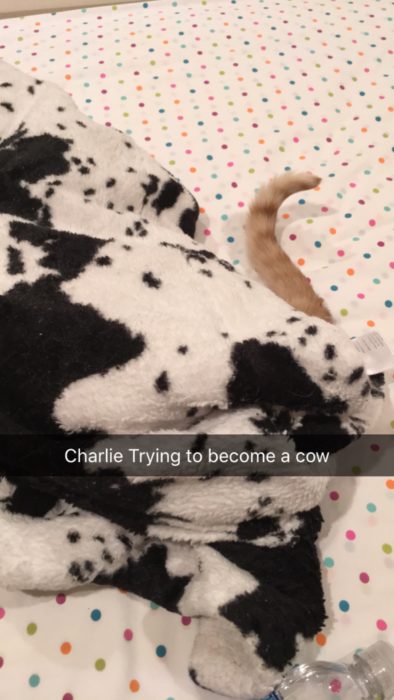My January/February is currently looking pretty crazy. I’m up to my ears in stress about how I’m going to make everything work, so I figured I might triple multitask for today’s blog post. As I’m sure I’ve mentioned about 1000x, I’m taking Microbiology right now (maybe I’ve mentioned it so much because it’s the class that never seems to end?). Along with the whole future career (hopefully) as a vet thing, this topic is something I wanted to look into for my own personal knowledge.
Today, I want to talk about the ethics of antibiotic use in livestock. I’m not going to take a side one way or another on this controversial topic, but I want to present that facts so that you, the reader, can make your own educated judgment.
(In the spirit of this post, let’s look at Charlie’s attempted transformation into a cow, followed by his rebirth many hours later as a blind kitty because the lights were too bright.)


Antibiotics have been used in livestock and food animals for decades. Antibiotics are used to treat sick animals, but they are often also given preventatively or in sub-therapeutic doses to increase the animals’ growth rate (it has been shown that low level antibiotic use increases the growth rate in some livestock).
Things to Consider:
- Antibiotics are given to sick animals to prevent pain and suffering. There is a required period of time between when the animals are given a drug and when they are allowed to be slaughtered for food; research has shown the antibiotic is either harmless to humans or sufficiently metabolized and degraded by this time.
- There is a concern antibiotics may make their way into the human food supply, and the effects of this are relatively unknown. Allergies to penicillin are fairly common, and one concern is that penicillin or penicillin derivatives in livestock could cause harm to these people.
- In 2006, Europe banned the use of low doses of antibiotics in livestock for the purpose of increasing growth.
- There is little regulation in the United States related to low doses of antibiotics in livestock.
- Antibiotic resistant bacteria. This is a HUGE concern. About half of the United States’s antibiotic use is in livestock. The extensive, unnecessary (for health) use of antibiotics is concern enough, but the fact that sub-therapeautic doses are given is even more problematic due to the nature of how bacteria tend to become resistant to antibiotics. Let’s discuss this. Let’s say we have a patient with a bacterial infection. The doctor prescribes antibiotics. After a few days of antibiotic treatment, most of the bacteria will be killed. Different individual bacterial cells will have slightly different levels of susceptibility to the drug, meaning some will be killed more easily due to genetic diversity. After a couple of days, the bacterial cells that are most easily killed are gone, and those that are naturally more difficult to kill remain. Each day, the number of living cells decreasing, but the cells that are able to survive are more resistant. If antibiotic use were stopped before the end of the treatment (i.e. if at day 7 of 10, the patient was “feeling good” and decided to stop taking the drug), the most resistant bacteria would remain and reproduce. This is why low levels of antibiotics is especially concerning: it allows bacterial to adapt (from generation to generation) to the antibiotic without being wiped out by it.
- What about preventative antibiotics? Here’s something to consider as well. Bacterial meningitis is a very serious and contagious disease. Sometimes when it is becoming an epidemic (such as in a college dorm), antibiotics are given preventatively. If we do it in humans, is it ok in cows? Does the severity of a disease make a difference in this decision?
- This is more of an unknown, but there’s also the concern of what antibiotics do to the animal’s normal microbiota. Bacteria live inside animals (and us!) quite harmlessly, and sometimes mutualistically (both bacterial and host benefit). Prolonged antibiotic use would change the normal distribution of bacteria in/on an animal, and we don’t really know what effect that might have.
I hope this information was helpful and made you think a little bit about our food supply!

